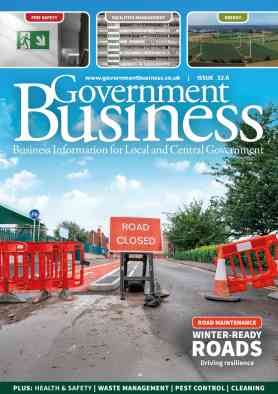
Meeting the challenge of operating vehicles in clean air zones
Air pollution features strongly alongside the climate change agenda in the 2021 Transport Decarbonisation Plan. The introduction of Clean Air Zones in cities is expected to bring pollution levels down significantly, but with a high percentage of HGVs and buses on the road dating from 2015 or earlier, a large number exceed the CAZ limits. To help tackle this challenge, Zemo Partnership and Energy Saving Trust has developed the Clean Vehicle Retrofit Accreditation Scheme (CVRAS), writes Neil Wallis.
Air pollution, of course, is not confined to the UK. Measures to improve air quality have been driven by European regulations and the World Health Organisation, latterly enshrined in UK law post-Brexit through the Air Quality Standards Regulation.
These regulations set legally binding limits for concentrations in outdoor air of major pollutants that impact public health such as particulate matter (PM10 and PM2.5) and nitrogen dioxide (NO2). The limits require a significant reduction of air pollution in towns and cities across the UK which exceed pollution limits, particularly for nitrogen dioxide, which is linked to thousands of deaths across the country. The UK is a signatory to a number of international agreements including the Gothenburg Protocol, and is bound to meet its international obligations post-Brexit so any weakening of the required standards isn’t expected.
Traffic is the problem
Air pollution problems are most challenging in densely populated areas and are strongly affected by traffic levels. As the dominant source of several key pollutants, measures to tackle vehicle emissions have focused, in particular, on general improvements in vehicle engine and aftertreatment technology and on limiting where more polluting technologies are allowed to operate. The first EC emissions standards were introduced for cars in 1970. Since 1992 EU regulations (now also enshrined in UK law) have been imposed on all new cars sold (Euro 1 to 6) with the aim of improving air quality - meaning a car has to meet a certain Euro emissions standard when it is manufactured. Standards for the emissions produced by trucks and buses were introduced from 1988 and have been periodically strengthened too.
It’s tempting, perhaps, to suggest that the revolution to electrify transport (that’s now well under way in the UK and elsewhere) will solve the air pollution problem in quick time. However, the latest projections suggest that 100 million new combustion engine cars are likely to be sold in Europe between 2025 and 2035 and, even here in the UK with the most ambitious phase-out targets, road vehicles with polluting emissions can still be sold in some categories until 2040, meaning that, unchecked, the air quality challenge could be with us for many years to come.
In the zone
At the local level, measures to limit air pollution have been spearheaded by the creation of zones where polluting emissions from traffic and other sources are controlled and closely monitored. These are variously known as Clean Air Zones, Low – or Ultra Low - Emission Zones or, in Oxford, as a Zero Emissions Zone.
There are currently four operational clean air zones in England: London (called the ULEZ), Birmingham, Bath, and Portsmouth (CAZs) with Oxford the first city to introduce a Zero Emission Zone (ZEZ) in a small pilot area. Different charges apply depending on vehicle type and size in each zone categorized into four bands (A to D) with those in Band D (such as London and Birmingham) applying the most comprehensive regulations, affecting almost all types of vehicles. Band A zones include only buses, coaches, taxis and private hire vehicles. (Other cities – like York – have introduced more limited regulations, targeted at diesel buses.) All zones adopt the same classification of vehicle emission standards (Euro 4/IV petrol and Euro 6/VI diesel).
Radical approach
Oxford has adopted the most radical approach so far; a pilot scheme charges all polluting vehicles - such as petrol, diesel, and even any hybrid cars – for entering the city centre with only zero emission vehicles, like fully electric cars, able to enter the zone for free.
A large number of other zones across the whole UK are set to be introduced or are currently under discussion, though some have been delayed or are under review as a result of the Covid pandemic. Lockdowns, of course, dramatically cut traffic levels and policymakers in several areas are reviewing the new traffic and related, modelled emissions situation in their localities in the wake of that large disruption to ‘normal’ travel behaviours.
Other important cities are expected to introduce charging zones this year, including Bradford and Bristol. The extensive Greater Manchester zone is currently under review while Sheffield, Newcastle and other centres are likely to follow. The Scottish Government is introducing similar policies with Low Emission Zones (LEZs) set to be introduced this year across Aberdeen, Dundee, and Edinburgh with Glasgow’s current bus-only LEZ to be extended to all vehicles.
Fewer choices for vans and buses
There is wide public and policy support for these zones and the cleaner air they bring, so it’s imperative that operators of commercial fleets are able to comply with the growing array of air quality regulations in the UK while continuing to be able to operate effectively. There’s already a wide and growing range of new electric vehicles available to car, van and bus fleet operators when it comes to vehicle replacement. However, larger van, truck and coach operators typically have fewer electric or zero emission choices. These heavier vehicles with requirements for longer range combined with operations in clean air zones, tend to be expensive to replace and may have bespoke bodies or equipment fitted, creating a challenge for their owners in many situations.
To operate in clean air zones introduced (or to be introduced) in the UK, all petrol vehicles need to be accredited to Euro 4 and Euro 6/VI for diesels. This applies to all CAZs, the London ULEZ and LEZs in Scotland. However, as noted earlier, there are differences in terms of the range of vehicles targeted and charged in (or excluded from) each zone. This is decided by the implementing authority and depends on the severity – and main causes - of the local air pollution problem. Of course, any vehicle sold in the last six years (or 16 in the case of petrol vehicles) meets these criteria, but with over 50 per cent of HGVs and 75 per cent of buses on the road dating from 2015 or earlier, there remain a large number of vehicles exceeding the CAZ limits.
To help tackle this challenge for operators, Zemo Partnership and Energy Saving Trust developed the Clean Vehicle Retrofit Accreditation Scheme (CVRAS). Introduced in 2019 the initiative now has 24 accredited retrofit systems listed on the CVRAS-Register.
The scheme includes a certification process to approve technologies that can be retrofitted to diesel vehicles to reduce regulated emissions and achieve Euro 6 / VI equivalent standards. The scheme covers black taxis, some vans, trucks, buses and refuse collection vehicles.
Technologies already accredited include exhaust aftertreatment technologies (SCR and DPF), engine replacement for battery electric powertrains, re-power and conversion to LPG and re-power with a Euro VI engine.
The CVRAS database
The CVRAS scheme is recognised by authorities responsible for clean air zones in England and Wales plus London’s ULEZ and Scotland’s LEZs and accredited vehicles are automatically exempted via their inclusion in the national CVRAS database, operated by EST. To date, over 9,500 vehicles are recorded as having been retrofitted on the CVRAS database, the majority with SCR and/or DPF exhaust systems installed. Vehicles operating with these systems on-board have been shown to cut emissions of nitrogen dioxide by over 80 per cent and fine particles by 90 per cent or more in real world operations.
Companies including HJS, Eminox, Proventia and Driveline are providers of exhaust retrofit solutions listed on the CVRAS Register. Solutions are available for a wide range of heavy goods vehicles, vans and buses.
Re-power
Cummins and Millbrook offer accredited Euro VI engine re-power options for several buses and some trucks, while Magtec has an electric re-power service for double and single-deck buses, a selection of HGVs and refuse collection vehicles. VRS, meanwhile, has completed 400 re-power and LPG conversions of black cabs.
Zemo Partnership and Energy Saving Trust are now regularly monitoring and reporting on the in-service performance of vehicles which have been retrofitted under the CVRAS Scheme as well as continuing to support the development of test procedures and the accreditation of new systems as they come on the market.
Whether or not retrofitting is the best option, in any case depends on an operator's circumstances. Some may find they are able to reorganise fleet operations such that their Euro 6/VI accredited vehicles are able to work in clean air zones while non-compliant vehicles operate in unregulated areas until planned replacement dates.
When zero emission (or Euro 6/VI compliant) products are available, bringing forward replacement cycles may be the best solution in a growing number of circumstances as more and more vehicles serving a wider range of uses come on to the market.
To support the CVRAS scheme, Zemo Partnership has updated the Clean Vehicle Retrofit Technology Guide which explains the retrofit technologies available and their application in different vehicle segments, with supporting vehicle operator case studies, an outline of how they are accredited as well as outlining the UK air policy framework which is driving the uptake of retrofit solutions.


